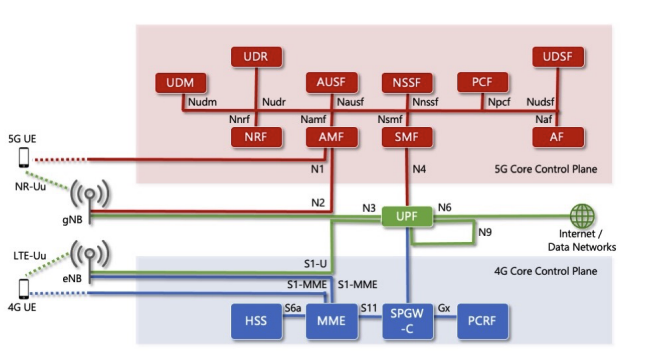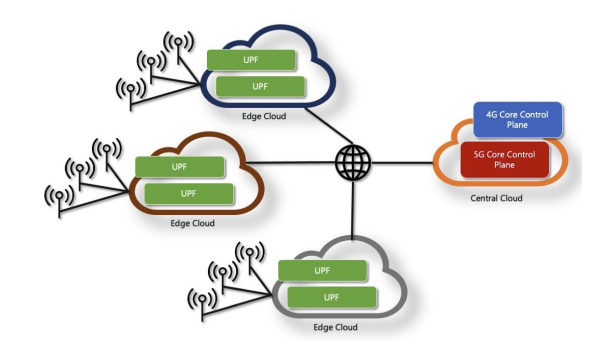SD-Core as a Cloud Managed Service
SD-Core is a flexible, agile, scalable and configurable dual-mode 4G/5G core network platform that builds upon and enhances ONF’s OMEC and free 5GC core network platforms to support LTE, 5G NSA and 5G SA services.
The SD-Core control plane provides the flexibility of simultaneous supports for 5G standalone, 5G non-standalone and 4G/LTE deployments.
SD-Core provides a rich set of APIs to Runtime Operation Control (ROC).
Operators can use these APIs to provision the subscribers in the mobile core and their associated access and connectivity policies.
Control runtime configuration of network functions e.g. management of Network slices
ROC includes built-in adapters for SD-Core to translate its monitoring and configuration APIs to customer and operator portals as well as third-party applications with corresponding levels of abstraction. Third party applications can leverage telemetry data to create applications for closed loop control.

SD-Core Architecture
SD-Core architecture enables the following distinct features:
All SD-Core components follow 3GPP standards to interface with others as well as the external networks and systems (e.g., RAN, communication services, etc.). As such, components can be consumed independently and be used as part of a multi-vendor mobile core deployment.
SD-Core’s 5G core control plane functions leverage seed code from the free5GC project, upon which the SD-Core community has implemented numerous architectural changes that are integrated and optimized with SD-Core’s set of UPF solutions along with several new features
The solution enables 4G, 5G Standalone (SA) and 5G Non-Standalone (NSA) connectivity.
The architecture is fully disaggregated, composed of containerized components. Helm charts are provided to deploy SD-Core on K8s cluster.
The platform is configurable in runtime via an extensible set of APIs.
The solution is consumable as a cloud-managed service.
All interfaces are designed to be robust in order to handle all network errors including but not limited to packet loss, peer network function failure, and duplicate packets.
SD-Core’s 4G Core is designed to have a CUPS (Control-User Plane Separation) compliant architecture and uses the 3GPP Packet Forwarding Control Protocol (PFCP) to implement CUPS
SD-Core’s 4G control plane has been enhanced to provide functional support for 5G Nonstandalone operation with compliant eNBs and gNBs as per 3GPP specifications. 5G NSA related enhancements include support of the extended bearer rates on required interfaces as well as the 5G NSA attributes in the HSS.

Multiple Distributed User Planes
SD-Core has two User Plane Functions (UPFs) designed to be deployed throughout the network edge. Each UPF is optimized to handle specific classes of application and take advantage of various hardware acceleration options. Deployments can intermix the UPF variants.
P4-Based UPF optimized for private enterprise deployments, and providing fine-grained visibility for verifiable performance and secure operations
Containerized Dual-Core UPF optimized for private enterprise deployments, capable of processing LTE and 5G traffic simultaneously
In SD-Core, a connected device is assigned to a UPF based on the network-wide slice configuration. Specifically, in 5G core, the SMF uses the network slice information received in the user session context as well as the Data Network Name (DNN) information received from AMF to select the serving UPF. In the case of 4G core, the SPGW-C uses the the Access Point Name (APN) information to select the serving UPF.
Network Slicing
Network slicing is one of the most important features of the 5G core network. Network slicing helps in isolating the network for various business and use cases. In the disaggregated service-based architecture of 5G core, this isolation may include only the UPF or also a subset of the control plane services such as the SMF. However, mobile core control functions that are responsible for managing user mobility, user authentication, and network slicing need to remain centralized across all slices. SD-Core provides the necessary APIs to manage network slices using external agents. ONF’s ROC, pre-integrated with SD-Core, allows for this central management via portals as well as automation. If the management requires instantiation of a new UPF and/or a new SMF instance, ROC oversees this by interacting with edge cloud or hyperscale container management services to provision such new network function instances.
Once all mobile core service instances are provisioned for a new slice, ROC uses SD-Core APIs to configure the slice as well as all required central network functions. SD-Core provides APIs to create and configure network slices and assign resources to each slice. Operators can assign a slice for a group of users/devices based on the use case. The behavior of each slice is configurable and can be dynamically changed during run time. SD-Core’s architecture supports assigning dedicated network functions to a specific slice or providing logical separation if network functions are to be shared among various slices. Various QoS and access policies can be applied to each slice to control the assigned resources as well as IP connectivity and access control within each slice. Operators can create new slices based on criteria such as isolating devices allowed to access specific packet data networks/edge applications or keeping all devices or flows with the same QoS classification grouped under one slice. Network slice selection is achieved through 3GPP-specified network functions like Network Slice Selection Function (NSSF) and Network Repository Function (NRF). NSSF helps in mapping the device/flow to a specific slice and steering the device/flow traffic to the right set of core network elements. SD-Core’s 5G implementation natively includes both NSSF and NRF for slice selection. As described earlier, SD-Core’s P4-based dual-core UPF allows for the monitoring of all 4G/5G traffic with fine-grained granularity using INT. This effectively means that with the P4- based dual-core UPF, it is possible to conduct per packet network monitoring to track whether slice-specific SLAs are being met and automatically adapt network behavior by changing per slice resource allocations, QoS priorities etc., to automatically sustain the required network performance using closed-loop control.
SD-Core Deployment Options
The level of disaggregation and associated optimizations achieved for each component of its 4G and 5G control plane makes SD-Core suitable for a wide variety of deployment options. These optimizations include the capability for the 4G and 5G control planes to oversee many UPFs, potentially instantiated at geographically diverse locations, as illustrated It is possible to deploy all components of SD-Core collocated in an edge cloud or a central cloud for private consumption. It is also possible to distribute the components of SD-Core across multiple clouds, edge and central, to deliver a cloud-managed multi-tenant connectivity service. In this distributed deployment option, SD-Core’s control plane will run on a central/hyperscaler cloud and control multiple user planes running on different onpremises edge clouds, potentially serving distinct customers as illustrated in Figure 8. In this deployment, the 4G and 5G control plane functions can scale as necessary. Each customer site can have more than one UPF deployed depending on the use cases and network slices configured. Operators can also decide to deploy UPFs in the central cloud for certain customers and their use cases where latency and data privacy is not a concern. SD-Core brings the flexibility to define network slices for each customer in such a way that one deploys a distinct UPF for each slice and instantiates the various components of the solution at the customer edge or in the central cloud, as needed and best suited.

SD-Core’s hybrid cloud deployment is an important enabler for a managed 4G/5G connectivity service where each customer site may be deployed to serve a different set of use cases and may have different types of underlying cloud environments. The 4G/5G core control planes running on the central cloud have been designed and optimized to support distributed edge sites which are spread across different locations across the world. The SD-Core control plane uses PFCP to communicate with the UPFs at the edge sites. The hybrid cloud deployment architecture has been optimized to handle variability in encountered delays communicating with the remote edge sites and is equipped to handle potential packet losses and retransmissions to support a multi-tenant, distributed geography deployment.